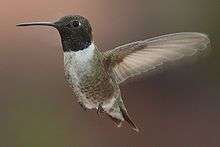Black-chinned hummingbird
| Black-chinned hummingbird | |
|---|---|
 | |
| Male | |
 | |
| Female | |
| Scientific classification | |
| Kingdom: | Animalia |
| Phylum: | Chordata |
| Class: | Aves |
| Order: | Apodiformes |
| Family: | Trochilidae |
| Genus: | Archilochus |
| Species: | A. alexandri |
| Binomial name | |
| Archilochus alexandri (Bourcier & Mulsant, 1846) | |
 | |
| Global range Year-Round Range Summer Range Winter Range | |
The black-chinned hummingbird (Archilochus alexandri) is a small hummingbird. It is an extremely adaptable bird, occupying a broad range of habitats.[2]
They are migratory and spend most of the winter in Mexico.
Taxonomy
A hybrid between this species and Anna's hummingbird was called "Trochilus" violajugulum. The black-chinned hummingbird is also known to hybridize with Costa's hummingbird.
As of 2011, it has the smallest known genome of all living amniotes, only 0.91 pg (910 million base pairs).[3]
Description
The black-chinned hummingbird is 8.25 cm (3.25 in) long. Adults are metallic green above and white below with green flanks. Their bill is long, straight and very slender. The adult male has a black face and chin, a glossy purple throat band and a dark forked tail. The female has a dark rounded tail with white tips and no throat patch; they are similar to female ruby-throated hummingbirds. Juvenile plumage is similar to that of adult females, but with buff margins on the dorsal feathers. Juvenile males may also possess purple feathers on their throats.[4]
Young are born almost featherless, but obtain a complete set of feathers within three weeks of hatching. Juveniles can begin replacing their plumage in November, and acquire their first basic plumage between April and May. Molts will then occur annually, taking 7–8 months at the population level.[5]
Similar species to the black-chinned hummingbird include broad-tailed hummingbird, rufous hummingbird, calliope hummingbird, Allen's hummingbird, lucifer hummingbird, Anna's hummingbird, and Costa's hummingbird.[6]
Distribution and habitat
Black-chinned hummingbirds are found in most of the western United States, reaching north into Canada in Alberta and British Columbia, east to Oklahoma, and as far south as Mexico.[2] They can be found in mountains, woodlands, orchards, meadows, and chaparral habitats. Their breeding habitat is open, semiarid areas, usually near water in the western United States, northern Mexico, and southern British Columbia.
Behaviour and ecology
These birds feed on nectar from flowers using a long extendable tongue or catch insects on the wing. While collecting nectar, they also assist in plant pollination.
The males and females of this species use different habitats from one another for breeding territories.[7] Black-chinned hummingbirds can exhibit territorial behavior around feeders as well as at other small feeding sites, and become more defensive as the breeding season continues. However, if there are a large number of individuals in an area as well as multiple food sources, this species will exhibit very little territoriality. Unlike most passerines, the agonistic call of the black-chinned hummingbird is acoustically complex, with notes ordered in non-random patterns, and are even more complex than their songs.[8] This species also uses diving displays (40–60 ft (12–18 m) dives) for territory defense as well as courtship, producing a variety of tones as air passes through their feathers during the plunge.[9]
The female builds a well-camouflaged nest in a protected location in a shrub or tree using plant fibre, spider webs and lichens. Black-chinned hummingbirds prefer to nest 6–12 ft (1.8–3.7 m) above the ground, often on exposed horizontal branches below the canopy. Research also suggests that they may purposefully nest near the active nests of much larger, predatory birds, as a means of reducing nest predation. The larger predators are too large and slow to be interested in the hummingbird, but their presence will deter other birds that might be interested in the black-chinned hummingbird's eggs or newly hatched chicks.[10] This species lays 2 small (8 mm (0.31 in) in width) white eggs at a time, incubating them for a period of 12–16 days.
Because of their small size, they are vulnerable to insect-eating birds and animals.
Status
Because of the black-chinned hummingbird's large range (236,000 km2 (91,000 sq mi)), large population size, and increasing trend in population (14.6% increase per decade), this species has been labeled as Least Concern.[1] Part of this increase is attributed to the increased popularity of hummingbird feeders and gardens.
References
- 1 2 BirdLife International (2012). "Archilochus alexandri". IUCN Red List of Threatened Species. Version 2013.2. International Union for Conservation of Nature. Retrieved 26 November 2013.
- 1 2 Baltosser, W.H.; Russell, S.M. (2000). Black-chinned Hummingbird (Archilochus alexandri). The Birds of North America. Pittsburgh, PA, US: The Birds of North America Inc.
- ↑ Gregory, T.R. (2005). "Birds - Animal Genome Size Database". Genomesize.com. Archived from the original on 14 May 2011. Retrieved 25 April 2011.
- ↑ Baldridge, Frank A. (April 1983). "Plumage Characteristics of Juvenile Black-chinned Hummingbirds" (PDF). The Condor. 85 (1): 102–103. doi:10.2307/1367900. Retrieved 5 April 2014.
- ↑ Baltosser, W.H. (April 1995). "Annual Molt in Ruby-Throated and Black-chinned Hummingbirds" (PDF). The Condor. 97 (2): 484–491. doi:10.2307/1369034. Retrieved 5 April 2014.
- ↑ "Black-chinned Hummingbird". The Audubon Society. Retrieved 5 April 2014.
- ↑ Berns, C.M.; Adams, D.C. (July 2010). "Bill Shape and Sexual Shape Dimorphism between Two Species of Temperate Hummingbirds: Black-chinned Hummingbird (Archilochus alexandri) and Ruby-Throated Hummingbird (A. Colubris)". The Auk. 127 (3): 626–635. doi:10.1525/auk.2010.09213. JSTOR 10.1525/auk.2010.09213.
- ↑ Rusch, K.M.; Pytte, C.L.; Ficken, M.S. (July 1996). "Organization of Agonistic Vocalizations in Black-chinned Hummingbirds" (PDF). The Condor. 98 (3): 557–566. doi:10.2307/1369568. Retrieved 5 April 2014.
- ↑ Feo, T.J.; Clark, C.J. (October 2010). "The Displays and Sonations of the Black-chinned Hummingbird (Trochilidae: Archilochus alexandri)". The Auk. 127 (4): 787–796. doi:10.1525/auk.2010.09263. JSTOR 10.1525/auk.2010.09263.
- ↑ Greeney, H.F.; Wethington, S.M. (December 2009). "Proximity to Active Accipiter Nests Reduces Nest Predation of Black-chinned Hummingbirds". The Wilson Journal of Ornithology. 121 (4): 809–812. doi:10.1676/08-174.1. JSTOR 20616992.
External links
| Wikimedia Commons has media related to Archilochus alexandri. |
| Wikispecies has information related to: Archilochus alexandri |
- Black-chinned hummingbird Species Account – Cornell Lab of Ornithology
- BirdLife species factsheet for Archilochus alexandri
- "Black-chinned hummingbird media". Internet Bird Collection.
- Video of a Female black-chinned hummingbird from Logan, Utah
- Black-chinned hummingbird photo gallery at VIREO (Drexel University)
- Audio recordings of Black-chinned hummingbird on Xeno-canto.
